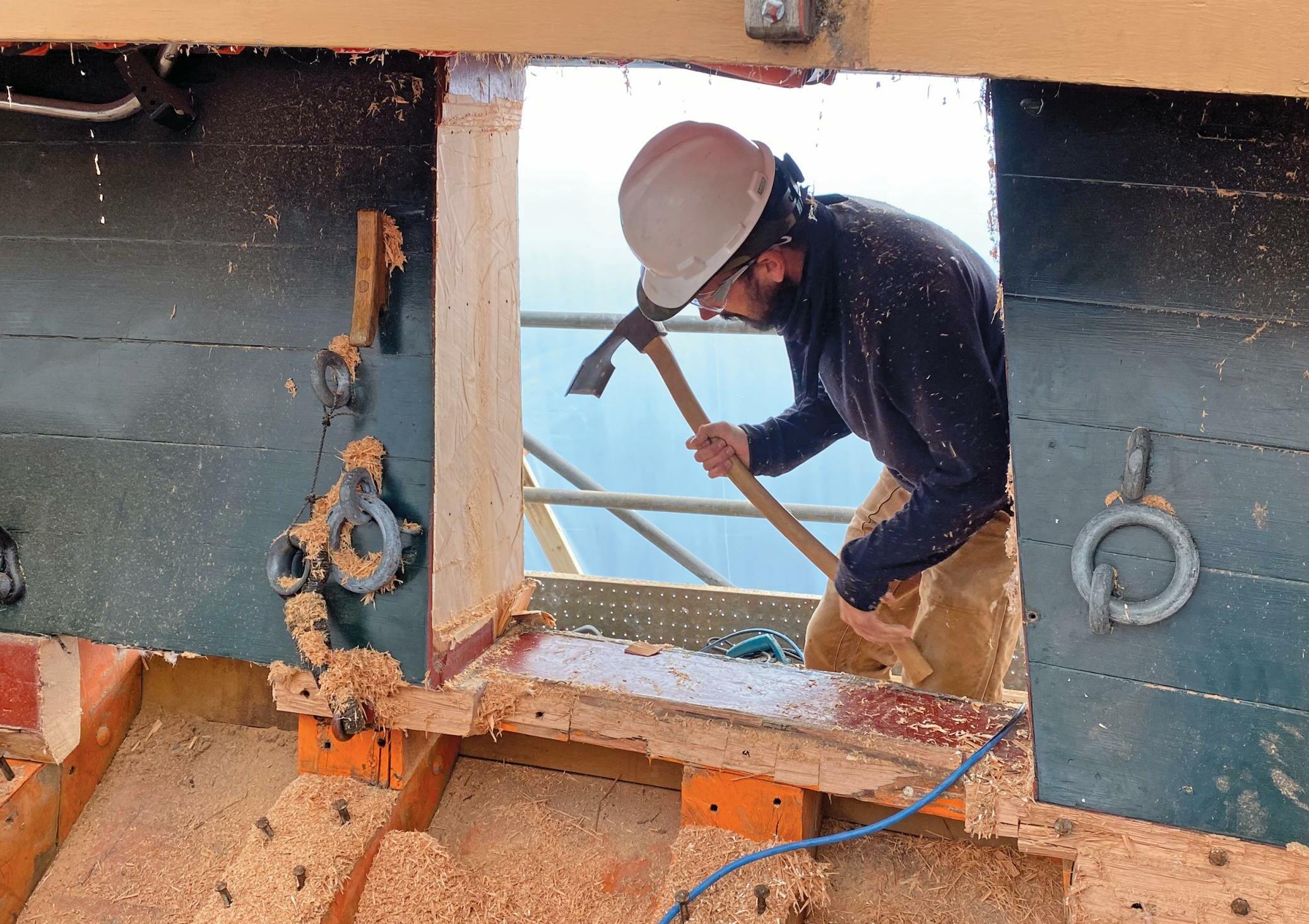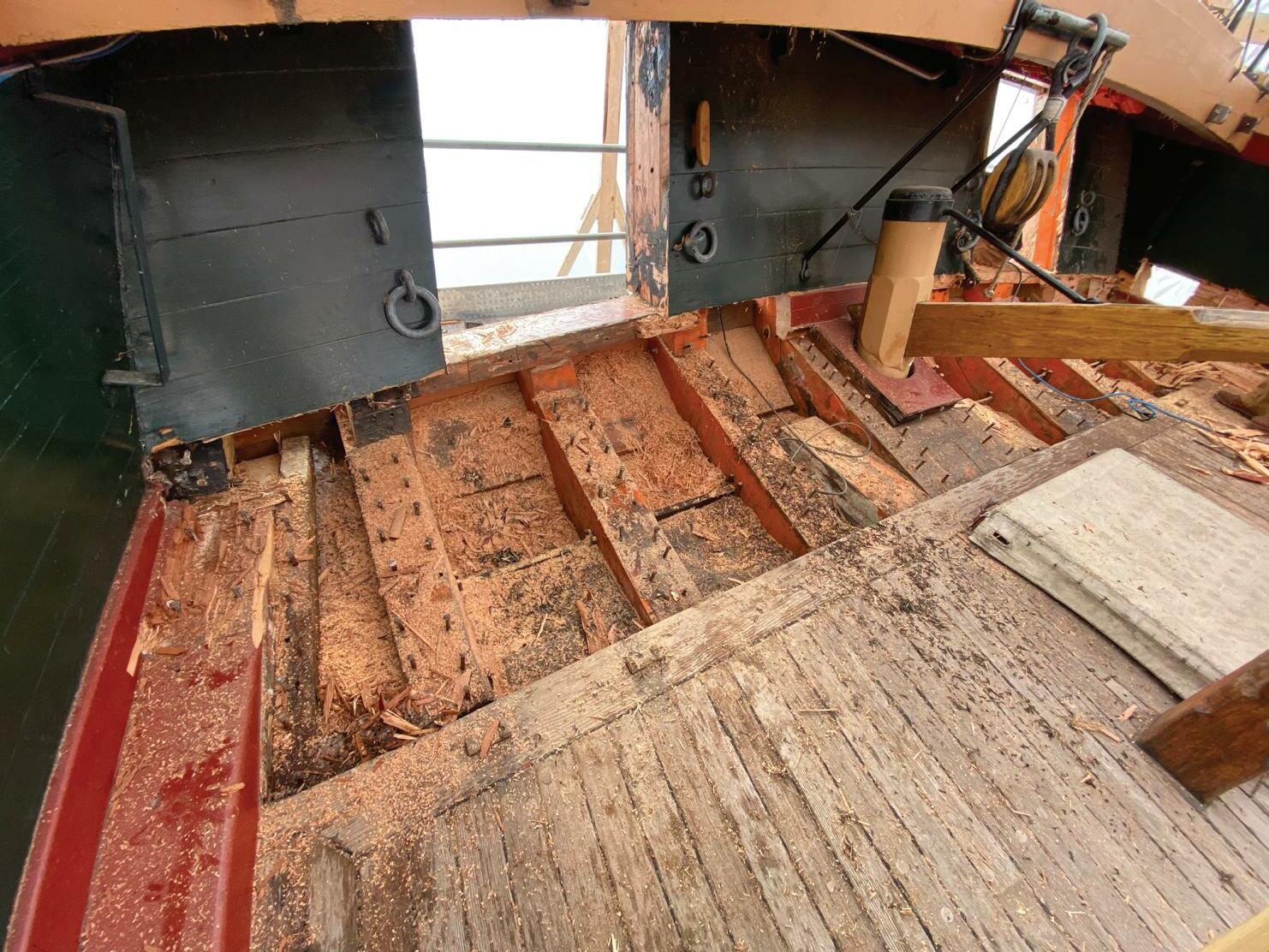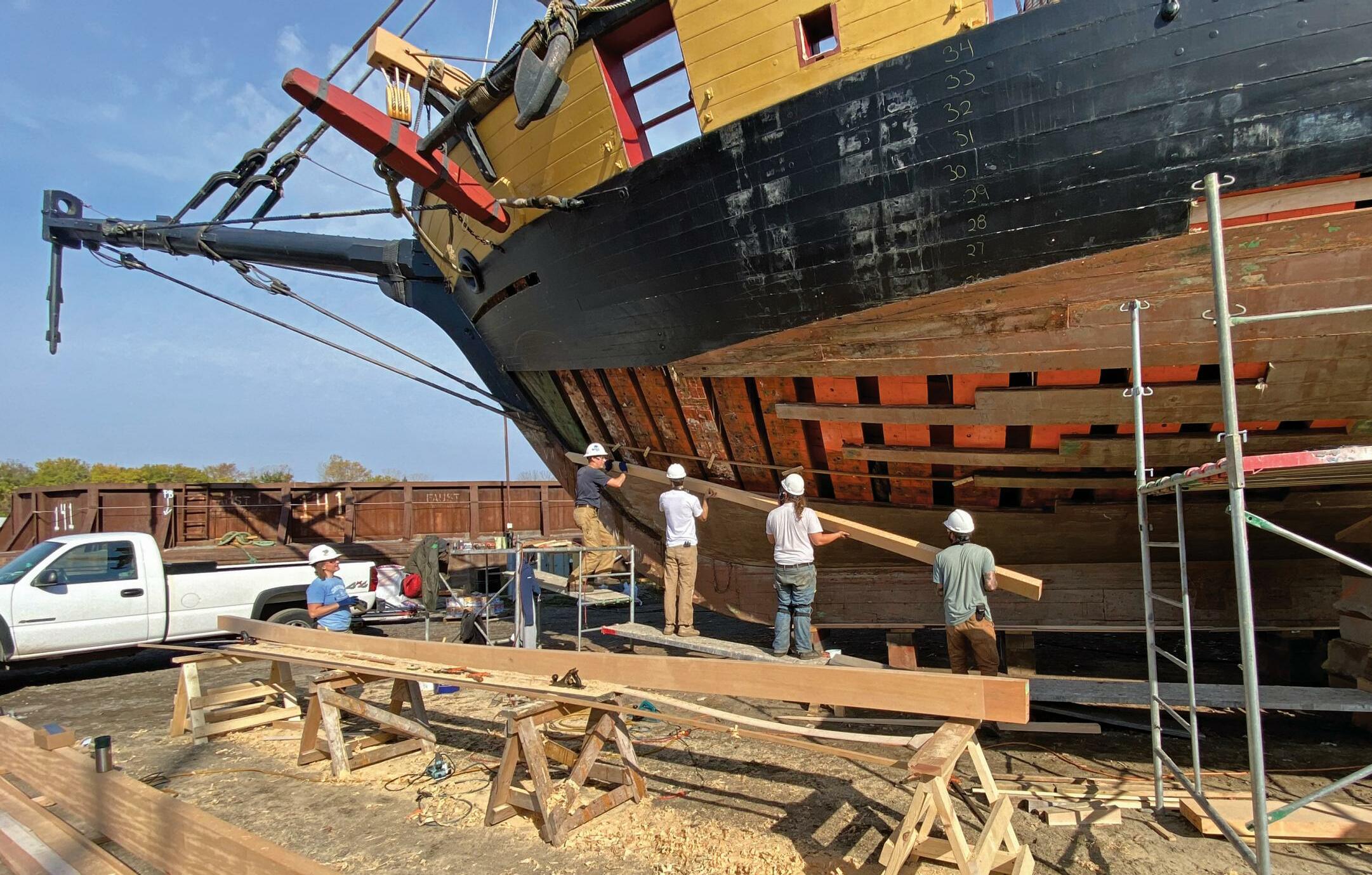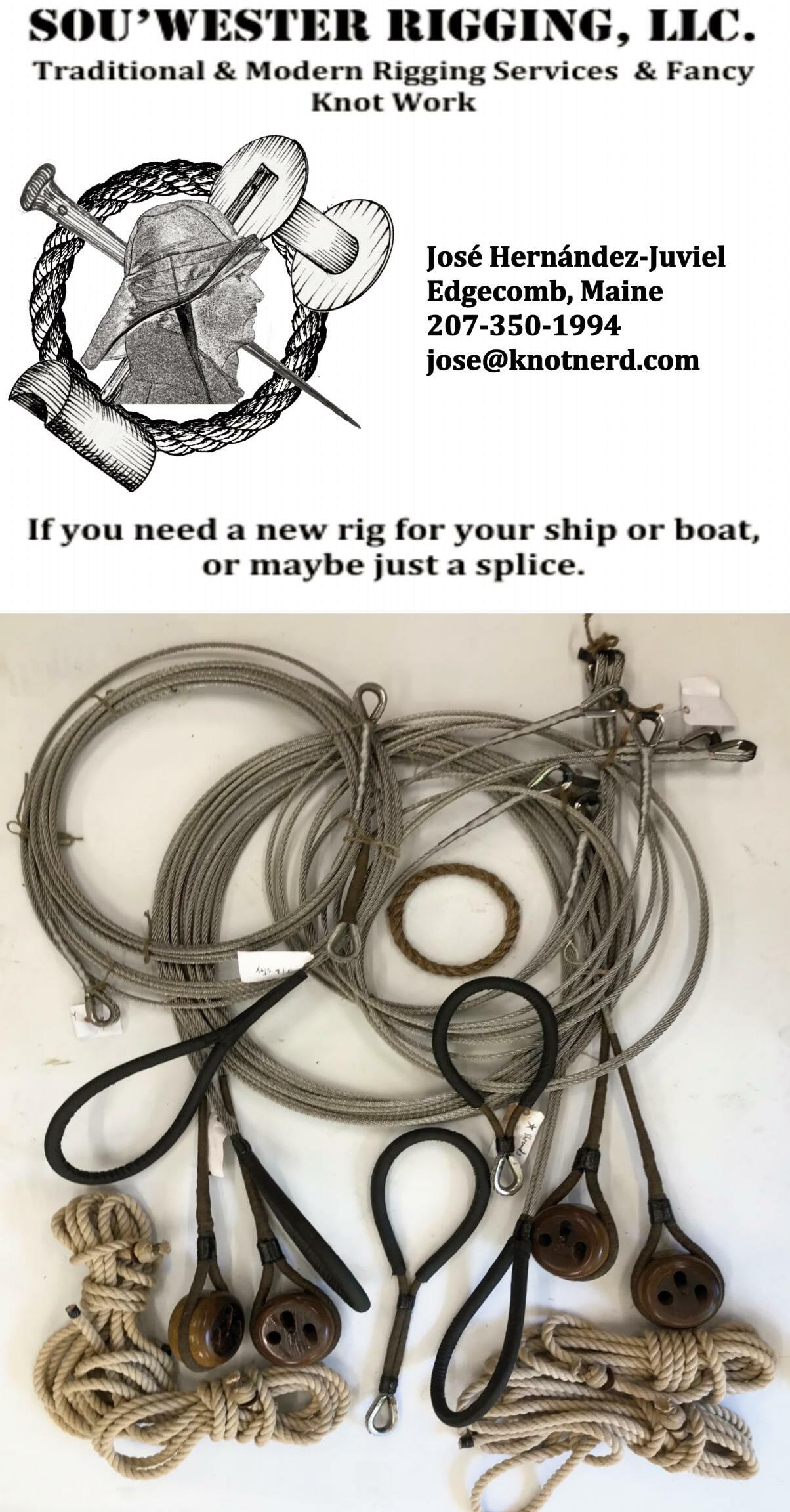
13 minute read
A Shipyard for Niagara
After a long delay due to COVID, the brig Niagara was finally able to head to Cleveland’s Great Lakes Shipyard this fall to take care of business
Marlinspike spoke to Capt. Billy Sabatini, Executive Director of the Flagship Niagara League, in mid-November.
Advertisement
Marlinspike: How’s it going in Cleveland?
Billy Sabatini: It’s going all right. They’ve stopped taking stuff off the ship and started putting it back on!
MS: This shipyard’s been a long time coming, right?
BS: We haven’t been there since 2016.
MS: We’ve just had the most amazing two-week stretch of weather in New England. I hope you got some of that.
BS: We have. It’s really been phenomenal. The last two weeks of October were pretty brutal here. I kind of wished we had kept Lettie [the 1893 fishing schooner Lettie G. Howard, on loan from South Street Seaport] sailing into November instead. But Lettie’s all done for the season and the winter cover is pretty much finished. Having excellent weather has been really, really helpful to help us get the work done we want to get done.
And I have to mention that this shipyard is being funded by the Commonwealth of Pennsylvania, through the Pennsylvania Historical and Museum Commission. It’s very important that they do get credit, because this would not have been possible without their funding. And they are the ones that own the ship!
MS: I was watching a local TV interview that you did, and you used the word “shocking” to describe seeing Niagara out of the water for the first time in forever.
BS: I think it’s shocking to anybody the first time they see that ship out of the water. It is just a really impressive thing to see, because Niagara is relatively low to the water. The big bulwarks are there, but the gunports are right down the deck. And so there’s a lot of ship underneath her. And when you first get to see just how big Niagara is, it truly is amazing. Like I said, in the interview, it was pretty shocking!
I like giving people the opportunity to see the ship. And I think it helps crew to understand what the underwater portion of the ship looks like, whether you’re doing it as a ship handler or even as a deckhand, just understanding the forces that are happening above you and how it’s affecting what the ship looks like underneath you.

Traditional tools such as this adze are still in use to maintain NIAGARA
MS: I thought maybe you were referring to outrageous bottom growth, or damage to the planking.
BS: No. I meant just the visual, or just being able to see Niagara fully. What does her whole shape look like? How deep is her keel? How big is her keel? Where is the turn of the bilge? Is it a round bottom? Knowing these things really helps when you’re sailing the ship.
MS: So do you think that the crew is able to connect what they see to the sailing characteristics of the brig?
BS: I think it’s always a pretty big eye-opener to see the ship, to see the bottom of the ship. I kind of feel that way about any ship, though, once you get it out of the water.
Then there’s different components to that too. When we’re looking at ships, we’re in the dock, we’re always looking down on them, for the most part, unless it’s a floating dock, then you might look up a little bit. And when you’re standing beside a ship, you’re looking up, you’re looking at it from a perspective you never get, as if you’re standing on the bottom of the lake, and looking up at the ship as if you were scuba diving. And it’s just such a unique perspective. And I think it always takes people’s breath away.
MS: What does she draw?
BS: About 11, 11 and a half feet.
MS: And has she got any drag to her? Or is it 11 pretty much consistently?
BS: It’s pretty consistent the whole way. I mean, we’re 9 1/2 forward, maximum 11 1/2 aft, but that keel runs the entire length of the ship.

NIAGARA’s transom
MS: You were saying in that same interview that you were replacing four planks a day, which is a pretty amazing pace. Were these planks that you had identified that there were problems with, before you got to the yard? You also mentioned that the boat had experienced some damage sitting at the dock and banging against whatever it is, camels or fenders. I don’t know what your docking situation looks like in Erie.
BS: No. We didn’t know what was going to be wrong until we got to the yard. We had our suspicions, of course. As with Lettie, we noticed a pattern of where the ship was worn more. And we found that it was the same type of pattern on Niagara. The side of the ship that was up against the dock... I’m not an expert in these things. But all I can figure is that the washing-machine activity of the water between the hull and the dock was actually causing damage to at least the seams. In Lettie, we had to re-caulk the majority of the wind-and-water line on the side that was tied to the dock.
And in Niagara, we had similar issues, where the side that was tied to the dock had ended up having more seams that needed to be reefed out and re-caulked and more planks that had to be replaced. But the biggest thing is just sitting at the dock. Ships do not do well when they don’t move. And I think that came into stark relief here as Niagara sat for two years without getting underway even once. And the amount of damage that was done to the ship — not damage, but deterioration — that we found, far exceeded any other yard period that we’ve had. And I really believe that not sailing for two years was a big reason for that.
MS: What does the dock look like, that Niagara is tied up to?
BS: It’s a solid dock that goes straight down. And so because of that, the water’s constantly bouncing between the hull and that dock wall.
And we breast the ship off too. So the ship isn’t hard up against fenders, alongside the dock. There is actually no fender contact. We haul the ship off and the fenders stay on the dock. If it blows really, really hard, they’ll make contact with the fenders, but we have the ship breasted off so that there is no contact with the dock.

MS: And you’re able to do that by what, running lines to the other side of the vessel?
BS: Yes. Our dock is such that we can run lines across to the other side. It’s almost like a slip, but it’s a really, really big slip. We have Lettie tied up on one side and we have Niagara tied up on the other. And we send offshore lines out to haul the ship away from the walls, so that we don’t have that constant contact.
MS: Getting back to the shipyard period — replacing four planks a day, are you happy with that level of production? That seems amazing.
BS: Yeah. It’s pretty good. You remember, Niagara’s planks are 3 inches thick, 27 feet long, and 8 to 12 inches wide. So we have a 30-foot steam box that we use. Really what’s limiting us is our tools. If we had more clamps or a bigger steam box, we could probably go a little bit faster. You can put multiple planks in the box. And then we have teams working to get everything going. We have 15 people working on a yard right now.
MS: Are these all your own people? Or is the shipyard providing some people?
BS: We’ve hired all the people ourselves.
MS: And how many of them are full-time Niagara crew and how many are temporary?
BS: The captain, shipwright and one of the crew that are part of our full-time crew. Everybody else was hired for this job.
Some are experienced boatbuilders and some are laborers. We brought in people that are more tall ships crew, that are there to assist the shipwrights as they’re working. That was the goal, to get the shipwrights that have the skilled labor and get more deckhand-type people that can assist them and keep them going.
MS: And where did you find the people that you hired?
BS: All over the country. I know that our shipwright made many, many phone calls all around the country to find the shipwrights. And we did the same, calling everybody we know to help to get some crew. And in the end, we got enough people to get the job done, but it took months. I mean, we started calling people back in July.
MS: Was there ever a point when you thought — I mean, everyone’s having difficulty hiring now — that you weren’t going to get a crew together?
BS: Yes. Absolutely.
MS: Yikes. How long was there between the crew coming together and the boat being hauled out?
BS: The last person arrived yesterday.
MS: [Laughs] Okay. And you say you’re already putting things back on the boat?
BS: Yeah. We have our full complement and now it’s a matter of just getting the ship put back together and getting her back in the water and enjoying a nice cold ride back from Cleveland.
MS: I assume that the Coast Guard has visited you.
BS: Oh, yeah. We have a great relationship with the Coast Guard in Cleveland.
MS: They must be as gobsmacked as anybody when they see Niagara.
BS: Yeah. I mean, everybody is. It really is an impressive thing. Many of the Coast Guard personnel though, in Cleveland, we’ve been working with them for many years. So it might sound kind of strange, but they’re used to Niagara.
MS: That’s interesting, because here on the East Coast we’ll see the same inspection team for three to five years and then bam! They all get re-assigned and we start over with a bunch of new folks.
BS: Oh, we’ve been very lucky to have many of the same inspectors yard period after yard period. And even with the inspectors that were coming in to do the underway portion, for many years we had the same inspectors. So we’ve been able to develop a relationship. And I think it’s a very positive relationship.

Hanging a new plank at the Great Lakes Shipyard
MS: Obviously, COVID delayed your shipyard period, but I’m sure that’s only one of many ways that you and your operations were impacted by the pandemic. So how are you doing in other respects?
BS: I mean, we weren’t able to hire a crew at all in 2020. That’s something that we never thought could ever happen. I’ve been with Niagara since 2005. And my goal every single year since I started working here was to make sure that Niagara was going to go sailing. And to have to make that decision that Niagara would not sail in 2020 was one of the hardest decisions I’ve ever had to make. So yeah, it affected us.
This year, being able to get Lettie out really was not just good for us as an organization, it was good for our community. Erie is used to having a tall ship sailing. And with Niagara not being able to get underway, having Lettie here, being tied up right downtown, out in the bay every single day, and doing a sunset sail every night... Lettie became the backdrop of Erie’s bayfront and has been since 2018. But this year, people really were excited to have that tall-ship presence on our bayfront again.
MS: What kind of signals is the Commonwealth of Pennsylvania giving you now? What kind of signals are you getting from the people who would normally fill up your programs in the summer?
BS: So that’s two different questions! We have gotten approval from the Commonwealth to sail Niagara in 2022. So that’s very exciting. We actually put out a press release last week about that. It didn’t get picked up though, because part of that press release was also that we were talking about shipyard and everybody in Erie was interested in what’s going on at the shipyard.
MS: Now, is there demand?
BS: Yes. We do have an idea of what programs we’re going to be doing all throughout next summer. We have longstanding relationships with many schools, both locally and nationally. And we also have affiliations with other programs and things that haven’t happened since 2019. But it’s looking like there is a demand and we’re looking forward to getting trainees sailing on Niagara again.
MS: And the cherry on top of the sundae — or maybe the straw that broke the camel’s back — is that there’s going to be a Tall Ships Challenge event on the Great Lakes this summer. Are you going to be able to fit everything in?
BS: Yeah. Yeah. I mean, we’ve always been able to do both. Niagara doesn’t necessarily do a lot of the day-sail type programming. We’ve almost never done it in May. And school gets out first week in June here. So we’re normally doing all of our high school and college based programming all throughout the summer alongside, and with, and part of the Tall Ships Challenge series. And then the end of the summer, we’ll be back here in Erie for Tall Ships Erie.
MS: So you’re three weeks into your shipyard now, and still hoping to return to Erie by mid-December?
BS: Yeah. I mean, I’m very happy and proud of the work that the crew’s doing out in Cleveland. I’ve been there for every yard period since 2006, and now with my role as executive director... the people out there are Adam Stanisz, our shipwright, and the captain, Chris Cusson. So I’m not out there every day, which is definitely unique for me.
I’m in Erie primarily. I go out maybe once a week just to see what’s going on and get an update, but I’ve stayed in Erie. I feel the best place for me is to not be in their way.
But I can’t say enough about the crew and how great of a job they’re doing... and also our community, Erie, Northwest Pennsylvania, and the Great Lakes: people all over the country really have been supporting Niagara throughout the pandemic. The people that care about Niagara and want to make sure that she’s still sailing, that’s how we were able to make it through this.
We’re very thankful that the people who care have continued to support us, even though the ship wasn’t sailing. We’ll make sure we get out there next year and take everybody sailing!
For more on the Flagship Niagara League, their boats and programs, visit www.sailfnl.org.





